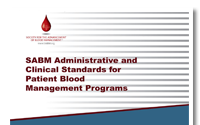NOVEMBER 2018
ISSUE

Please consider making a donation to your Society. Your donations will help us to improve the lives of people throughout the world through Patient Blood Management.


SABM 2018 Newsletter Publication Schedule
March | July | November
Carolyn Burns, MD
Editor
Tiffany Hall, RN
Associate Editor
Sherri Ozawa, RN
Kevin Wright
Contributors for This Issue
Allison Jones, PhD, RN
Becky Rock, RN
Marketing & Membership Services
Carmen Melseth
SABM Officers and
Directors
© 2018 Society for the Advancement of Blood Management
350 Engle Street Englewood, NJ 07631 USA Phone: (928) 551-6400 Fax: (877) 944-2272 EMAIL: [email protected] |
Standards Showcase
STANDARD 8: PHLEBOTOMY BLOOD LOSS
There are written guidelines for minimizing blood loss due to phlebotomy for diagnostic laboratory testing.
A recent survey of selected nurses revealed that while most considered standing laboratory orders to be routine, the connection to anemia was not immediately drawn although fully realized once discussed. In fact, published data suggest that phlebotomy blood loss for a patient may exceed an average of 40 mL per day in critical care units and is also a major contributor to anemia in low birth weight neonates. Therefore, an aggressive strategy to reduce phlebotomy blood loss must be part of comprehensive patient blood management.
Indicator 8.1 states: Hospital policies and processes that pertain to phlebotomy for diagnostic laboratory samples address the importance of obtaining only the minimum volume of blood necessary to carry out the ordered laboratory tests, and ordering the minimum number of tests needed to manage the patient clinically.
Indicator 8.7 states: The Patient Blood Management Program in coordination with the laboratory and clinical leadership reviews the frequency of inadequate and mislabeled samples in addition to test ordering patterns and sample requirements to decrease the need to re-sample, reduce unnecessary tests and minimize sample volume.
All patients are at risk for developing anemia, and the ever-increasing body of evidence has established an association between excessive phlebotomy and anemia with an increased risk of morbidity and mortality. Therefore, laboratory testing needs should be re-evaluated at least on a daily basis. Strategies such as point-of-care testing and microsampling, either by use of pediatric tubes, new low volume full size tubes or by using the minimum allowable sample volume in adult tubes, can be simple and effective to teach yet requires diligence to fully implement.
SABM provides educational resources for clinicians leading to increased awareness and improved outcomes. These evidenced-based Standards further this goal by addressing unmet needs in clinical activities related to patient blood management which serves to benefit all patients.
Contributor: Kevin T. Wright
 |




FOLLOW US ON INSTAGRAM

|